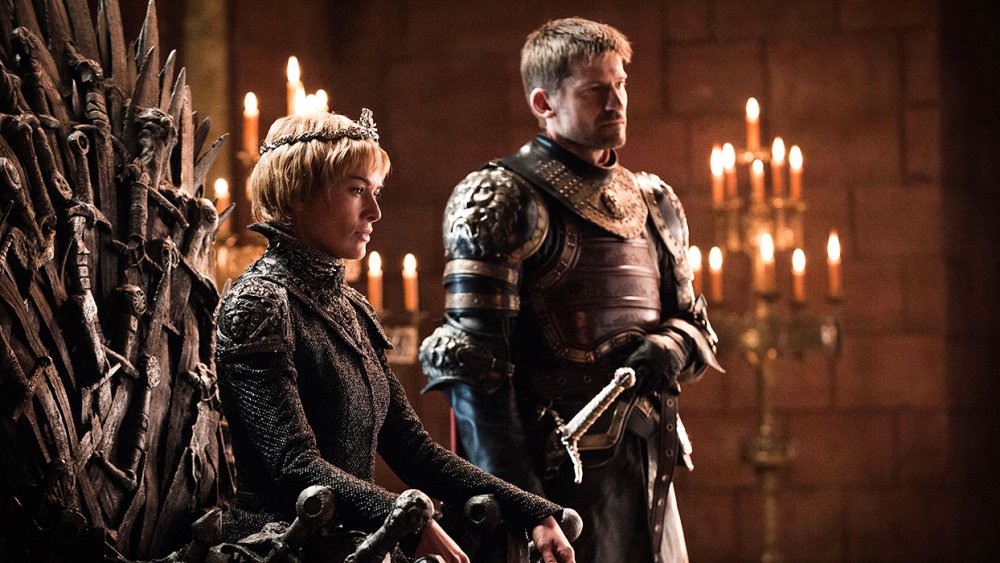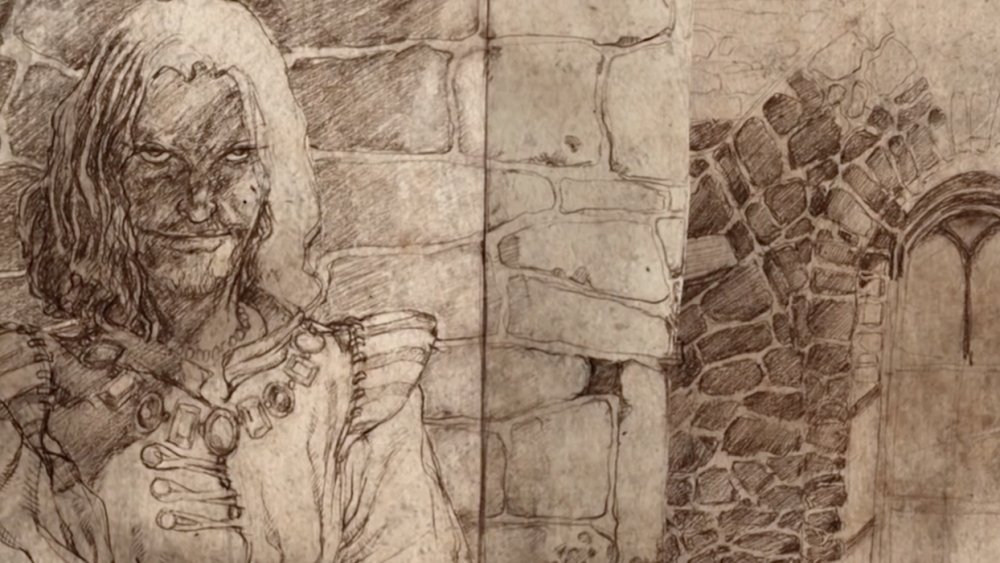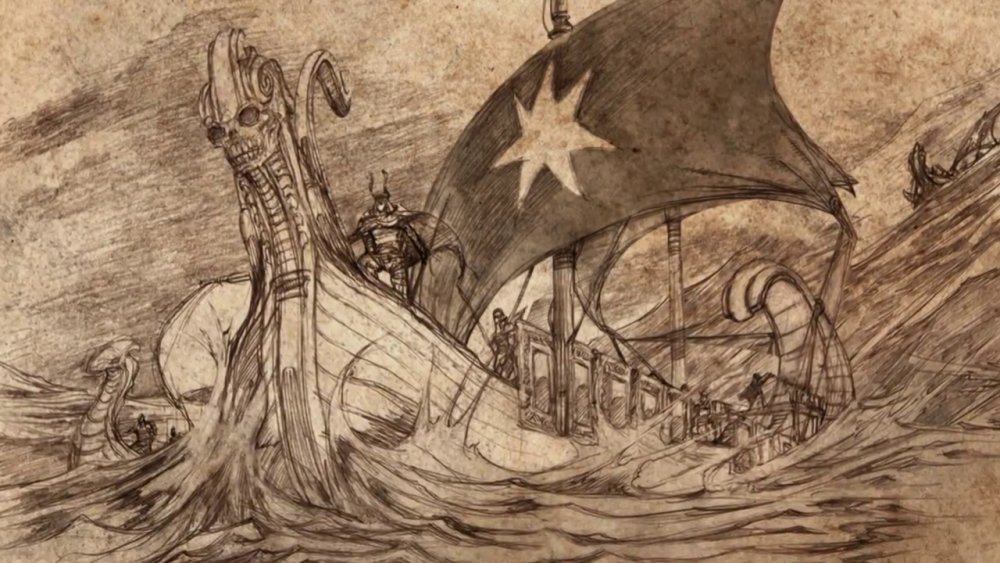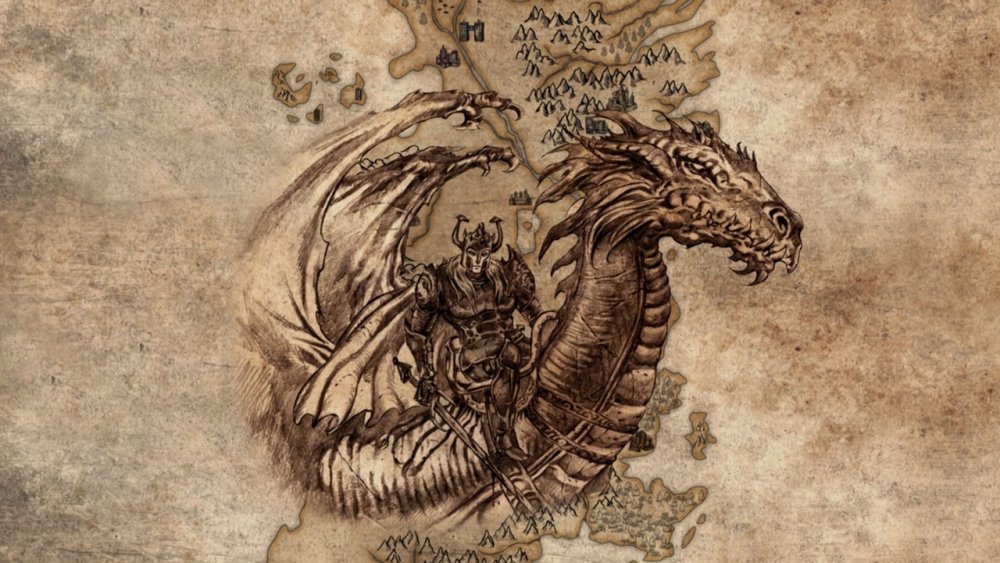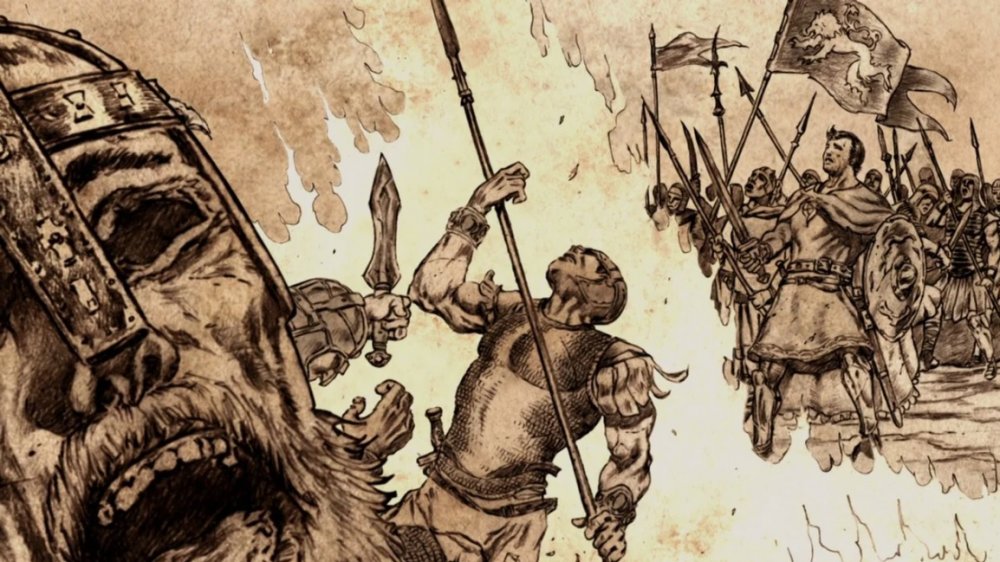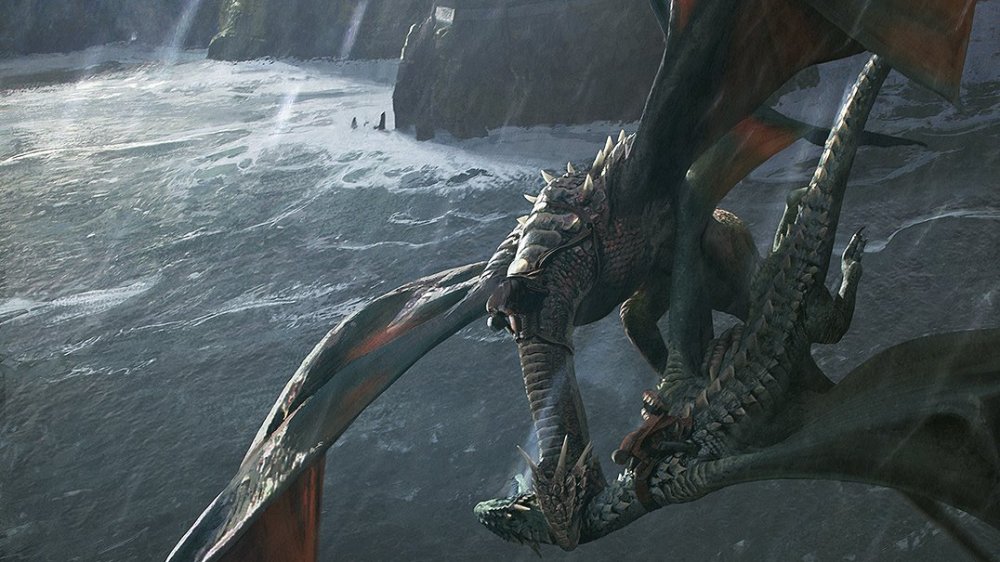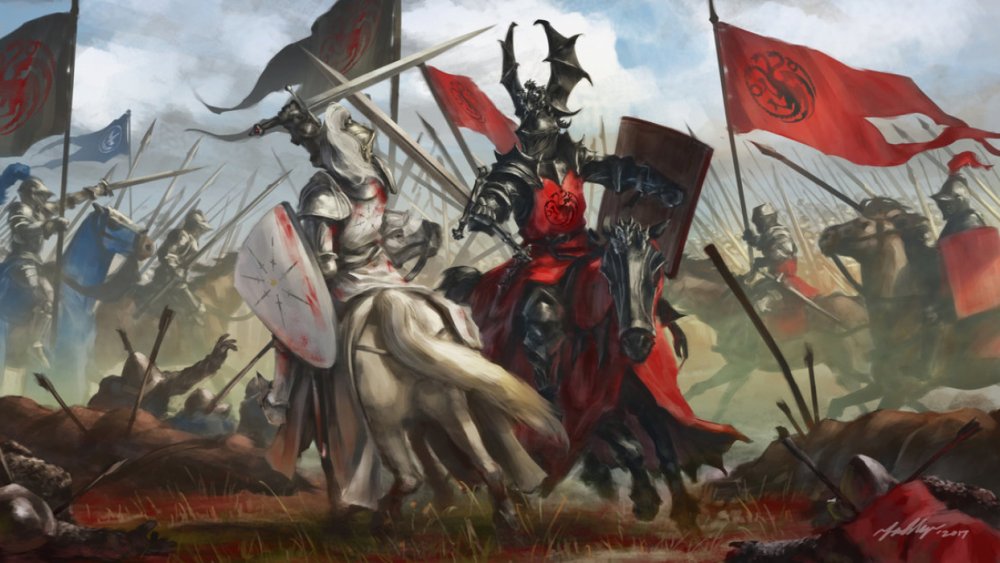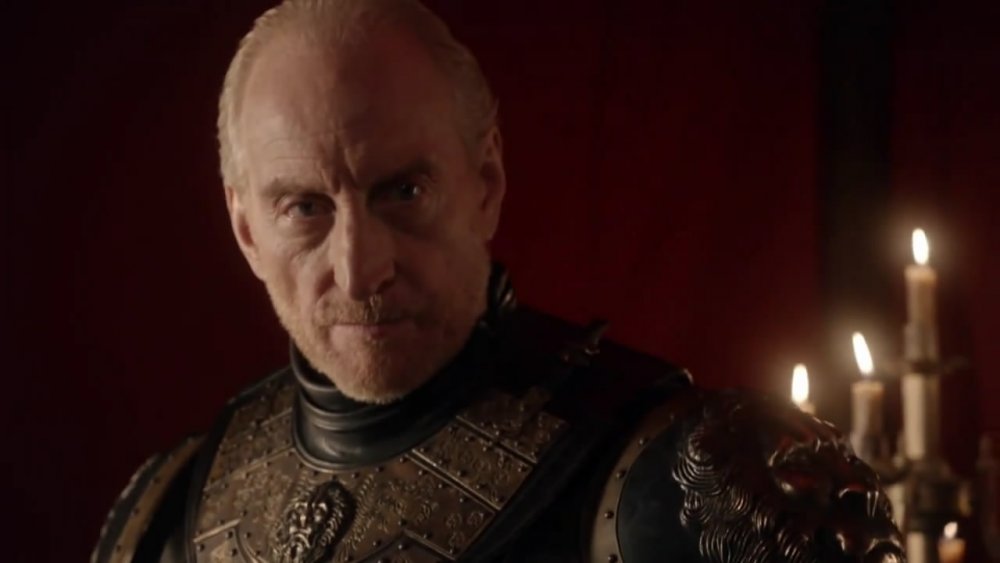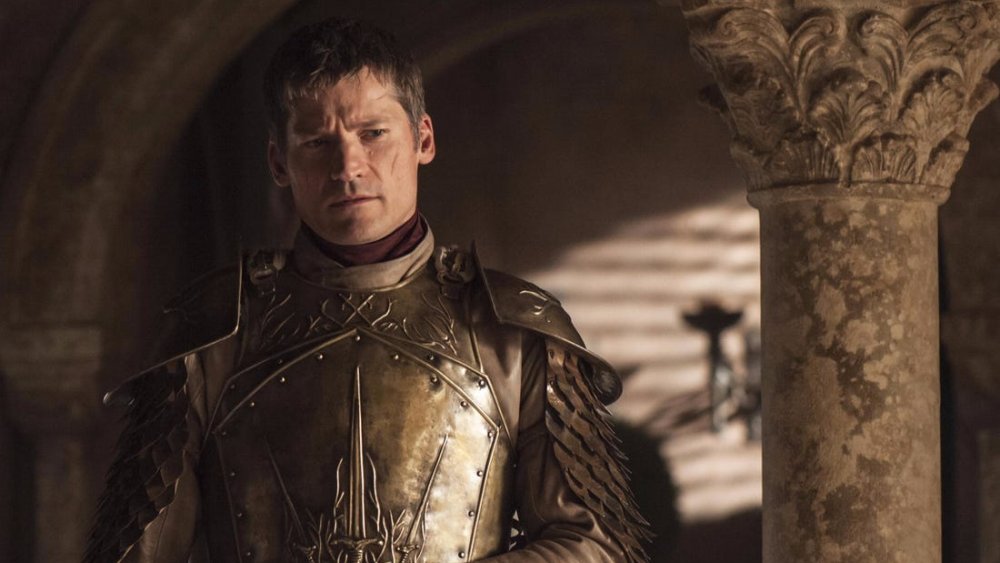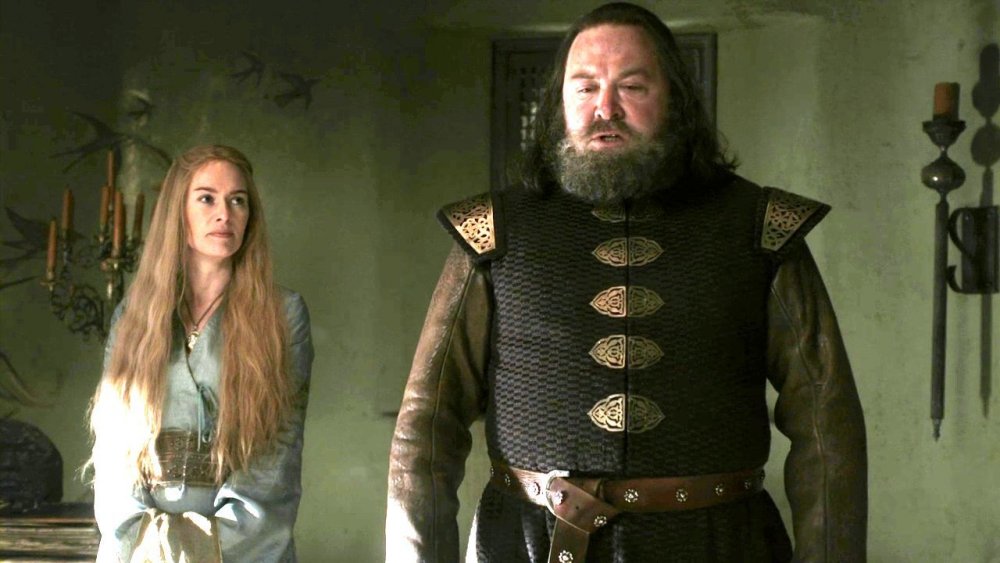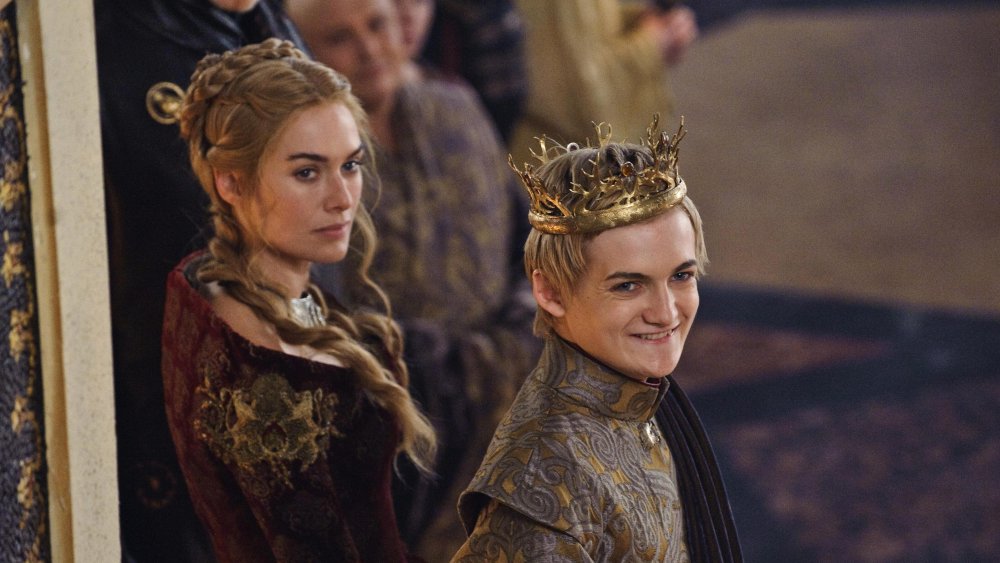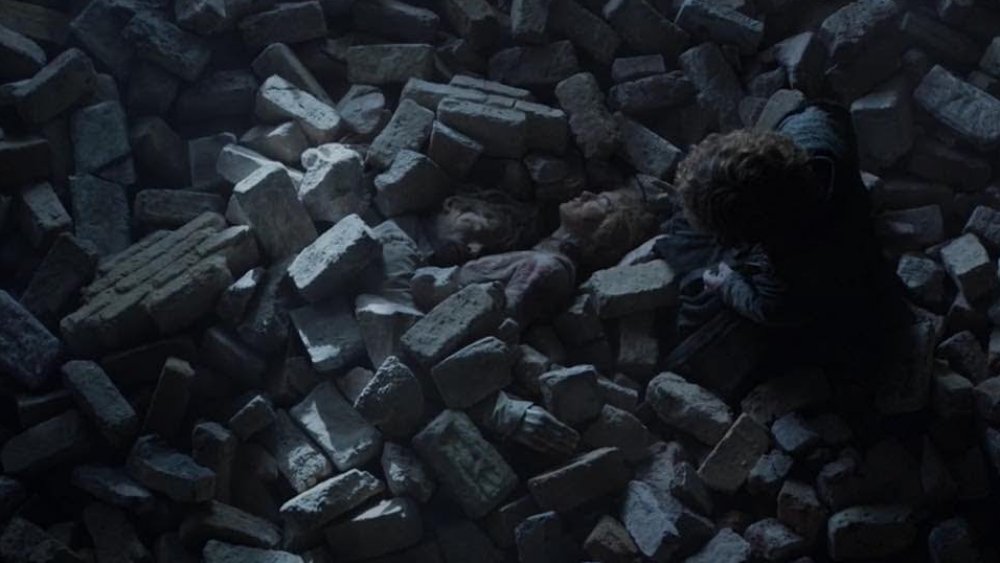The Entire House Lannister Backstory Explained
Game of Thrones is full to the brim with engaging characters and captivating stories, much of it bound up in the series' many noble houses. Fans first meet the Starks, marked by their strong sense of duty and connection to the North. Then there are the feuding Baratheon brothers, torn apart by desire for kingly glory. The salt-streaked Iron Islanders captivate from their bleak corner of Westeros. And then there are the Lannisters. Though Tyrion, black sheep of the family, was an immediately embraced by fans, few would call the scheming house their favorite.
That's a real shame, as the Lannisters are fascinating. Sure, they're jerks — but they're also incredibly complex. Famous for their wealth, they've secretly fallen on hard times and are coasting on the prestige of their name — to say nothing of the incest at the heart of the noble clan. The Lannisters' struggle to hold onto their riches, ensure the next generation's stability, and expand their claim over Westeros is just as interesting as anything out of Winterfell — and we're here to explore it. This is the story of House Lannister, from their ancient origins to the history of Casterly Rock.
Lann the Clever
Many Westerosi nobles can trace their heritage back to a single legendary ancestor. The Lannisters claim Lann the Clever as their progenitor, a fabled trickster who swindled Casterly Rock out from under its original owners. Many stories swirl around this figure: Some are outright fanciful, like the legend that claims Lann stole gold from the sun to brighten his hair, while others seem to be based more solidly in reality. What is certain is that Lann lived by his wits.
One story claims that Lann hoodwinked Garth Greenhand, fabled ancestor of many Reach families, by pretending to be one of his many heirs. Others describe him as an Andal adventurer. His most famous story, however, is concerned with his theft of Casterly Rock. Though different versions disagree on the details, in all cases, Lann played the members of House Casterly against one another, forcing them to abandon their castle. In some stories, he convinced them their home was haunted by sneaking around the dungeons. In others, he filled the home with lions and turned them on the doomed family. Whatever his methods, the story instilled in future Lannisters a respect for cunning and guile over sheer brute force.
Coming to terms with the Andals
Though the First Men were the first humans to set foot on Westerosi soil, they were not alone for long. The Andals, a people from the northern hills of Essos, received a vision from their seven-faced god, urging them to conquer the lands across the sea. And so they did, first landing in the mountainous region known as the Vale. From there, they invaded Westeros with overwhelming force.
The Andals were wildly successful in the southern regions, wiping out the culture of the First Men wherever they went. While the Lannisters, already established as a house, initially fought the invasion, a more peaceable method of holding onto power emerged: King Tyrion III and his son, King Gerold II, made inroads with the Andals through marriage. Andals were given titles and land, quickly intertwining with the Lannisters, who became known as an Andal house, despite their First Men name. Thus the Lannister retained their power, name, and position at Casterly Rock.
Rising up against the Targaryens
This peace held for centuries, until yet another Essosi clan tried their hand at taking over Westeros. House Targaryen were the last surviving nobles of a massive Eastern empire known as the Valyrian Freehold. Old Valyria, as it came to be known, was distinguished by its advanced technology and command of dragons. A cataclysm known as the Doom of Valyria brought this age to an end — though not the Targaryens, who slipped away from their ancestral home a few short years before the entire civilization collapsed.
The Targaryens settled on Dragonstone. It wasn't long, however, before they set their sights on Westeros. Roughly 100 years after the Doom of Valyria, Aegon Targaryen set out to conquer the continent with the help of his two sister-wives and their three fearsome dragons. Many kingdoms immediately submitted to Aegon out of fear of his dragons. This was hardly foolish: Resistant lords like Harren Hoare were cooked alive in their own castles. Seeing the advancing conquest, the Lannisters teamed up with the Gardeners in the Reach, putting together an army of 55,000 men to rebuff Aegon and his dragons.
The Field of Fire
Defiance didn't go any better for the Lannisters than it did for the vanquished houses of the east. But the Lannister-Gardener army (known to history as "The Host of the Two Kings") was mighty, and seemed initially able to resist Aegon's onslaught. This wasn't unprecedented: The Dornish managed to keep hold of their independence, and Aegon's army had been significantly weakened.
Aegon met the 55,000-strong army with a mere 10,000 men, largely conscripted from conquered houses. With their superior numbers, the Lannisters and Gardeners hoped to outflank Aegon's army and quickly rout the small force. Aegon warded this off by arranging his men in a crescent that made it difficult to surround him, but to little effect — the Host of the Two Kings was mighty enough to quickly smash through enemy lines.
But dragons have a way of changing the math of warfare. Aegon and his two sisters unleashed all three of their dragons on the battle for the first and final time, setting the battlefield ablaze and killing 4,000 men. This battle became known as the Field of Fire, and its effects were enormous: The entire Gardener line was wiped out, the swords of the defeated were eventually made into the Iron Throne, and Westeros was made fully aware of what three dragons could do to even the mightiest army.
Choosing sides
The events of the Field of Fire effectively cowed the Lannisters. They submitted to Aegon's rule, who brought the family in close by offering them stewardship of the west. Loren I became Warden of the West, and was allowed to keep Casterly Rock, so long as he remained loyal to the Targaryens.
A little over a century following this conquest, the Dance of the Dragons, a Targaryen civil war, broke out. Because of their esteemed position within the Targaryen administration, the Lannisters sided with the crowned king, Aegon II. The war proved to be yet another opportunity for the Lannisters to increase their wealth. Lord Tyland Lannister, named master of coin at the outset of the war, immediately split the treasury into four parts. He sent one quarter back to Casterly Rock, one quarter to the Iron Bank at Braavos, one quarter to Oldtown, and put the final quarter into circulation, hiring mercenaries and enabling bribes. Tyland was horribly disfigured over the course of the war, having been captured and tortured by the aspiring queen, Rhaenyra. But he refused to give up the location of the realm's gold, and so it remained under his control when Aegon's heir took back control of Westeros.
The Blackfyre Rebellion and a rough patch
The Lannisters remained loyal to the Targaryens throughout almost all of their rule, maintaining their grip on the west and their position in the king's ear. This held true during the Blackfyre Rebellions, when illegitimate sons of late Targaryen kings rose up to claim the throne for themselves. The Blackfyres were ultimately crushed by Targaryen forces and exiled en masse to Essos.
Though the Lannisters were finally on the victorious side of a war, all was not well in Casterly Rock. The Lannisters had the misfortune of being led by a weak-willed man named Tytos Lannister, whose position as Warden did little to keep his vassal houses in line. Casterly Rock's vast treasury was slowly depleted by houses who realized Tytos did not have the stomach to force them into repayment. Seeing an opportunity to claim the western lands for themselves, House Reyne and House Tarbeck rose up in defiance of the Lannisters.
Return to glory
Tytos' heir Tywin Lannister was his father's opposite. He ordered all debts to the Lannisters repaid, and put together a military force to attack all who would not comply. Both the Tarbecks and the Reynes refused the order. In response, Tywin captured Lord Tarbeck and held him hostage. Lady Tarbeck countered by capturing three Lannisters and ordering her husband returned. Though Tywin wanted to send Tarbeck's body back in three pieces, his father balked at the idea. Ultimately, there were no immediate consequences for this incident, and all family members were returned.
Feeling secure, the Tarbecks and Reynes laughed Tywin off when he ordered them to answer for their treatment of the Lannisters. They renounced their fealty to Casterly Rock — and, to their shock, paid dearly for it. Tywin decimated the Tarbecks in battle before laying siege to their castle. Lady Tarbeck declined a peace offering, so Tywin knocked her castle's keep to the ground and set the ruins on fire.
The Reynes attacked the Lannisters outside the ruins, but were beaten back. When the entire family attempted to hide in the mines underneath their castle at Castamere, Tywin sealed the entrances and filled the caverns with water. After the Reynes drowned, Tywin set their castle on fire. Having seen what came from rising up against this new generation of Lannisters, the rest of the west fell back in line.
Turncoats
After his father's death, Tywin became the Lord of Casterly Rock and the Hand of King Aerys II. He served in this role for many years. Seeing the Lannister name besmirched by his father gave him an almost pathological obsession with leaving a strong family legacy. As such, he commanded his children to act in ways that would consolidate and sustain Lannister power. This was easier said than done, however: His twin children Jaime and Cersei were incestuously involved from a young age, and Tyrion, his youngest son, was a dwarf whose birth killed Tywin's wife, Joanna. Tywin still managed to use his children to move deeper into the halls of power, but his frustration grew — as did his family's dysfunction. When Jaime could not marry his sister, he joined the Kingsguard to be close to her, believing she would be wed to the next Targaryen king.
The Targaryens refused Cersei, causing Tywin to resign his position as Hand of the King. The Lannisters remained neutral for much of Robert's Rebellion: Tywin only joined the fight after Robert Baratheon's defeat of Rhaegar Targaryen. As the city was sacked, Jaime stabbed the "Mad King" before he could burn the city of King's Landing to the ground using explosives stashed beneath the streets. Thus, Jaime became the "Kingslayer" and the Lannisters established themselves as loyal to the Baratheons.
Robert's rewards
Tywin was rewarded handsomely for his decision to turn on the Targaryens. His daughter Cersei was married to the new king, Robert Baratheon, becoming Queen of Westeros and cementing Lannister control over the entire kingdom.
Robert Baratheon was, however, much more of a fighter than a leader. His time on the throne was marked by rampant spending on feasts, fun, and the occasional small-scale war, nearly all of it financed by the Lannisters. Because of the extreme debt the crown owed the Lannisters, the family became regarded as the realm's true reigning house, and Tywin Lannister as one of its most powerful figures.
Cersei gave Robert several heirs in Joffrey, Tommen and Myrcella. Though they all carried the Baratheon name,their striking blond hair fueled (entirely true) gossip that they were, in fact, fathered by Jaime, and therefore had no claim to the throne. This quickly became an issue when Robert died from wounds sustained on a hunting trip and the young, cruel Joffrey ascended to the throne.
Royal family
The Lannisters managed to hold onto power following Robert's death. Though Cersei attempted to raise Joffrey with care, he was a terrible ruler with a lust for violence and absolutely no long-term thinking.
Robert's Hand, Ned Stark, was captured by the Lannisters when it became apparent that he knew the truth about Joffrey, Tommen, and Myrcella's parentage. The North rose up to free their lord, and a temporary peace was brokered. Joffrey told Sansa Stark that he'd free her father if she could convince him to recant his claims. The Starks held up their end of the bargain ... but Joffrey had Ned Stark executed anyway. This led to a period of major unrest known as the War of the Five Kings. Though the Lannisters weathered it, they sustained major losses, including the deaths of Joffrey, Tywin, and Myrcella.
Tommen, a considerably kinder boy than his brother, next took the throne, but his age and naivete were weaponized against him. He was taken in by a group of religious zealots who had taken root in the capital, allowing his mother, wife, and brother-in-law to be captured by the sect and tortured. Cersei was forced to walk naked through the streets of King's Landing, and then expected to stand trial alongside Loras Tyrell.
Laid low
Things grew even more grim for the remaining Lannisters. Rather than stand trial for her crimes, Cersei destroyed the Sept of Baelor, killing most of the Tyrells and many members of the militant sect. Horrified by his mother's violence and sacrilege, in addition to the death of his wife, Margaery Tyrell, King Tommen threw himself out a window of the Red Keep.
Tommen was Cersei's last living child. With no heirs left and only a few allies, Cersei assumed the throne and became the first Queen of Westeros. Her reign did not last, however: Cersei and Jaime were ultimately killed during Daenerys Targaryen's attack on Kings Landing. Only Tyrion Lannister survived the War of the Five Kings, the destruction of King's Landing, and the invasion of the White Walkers. At the series' end, he had risen to a very high position indeed, being King Brandon Stark's Hand and the Lord of Casterly Rock. Yet the Lannisters' fighting forces had been decimated, and the treasury was no longer the rich vault it had once been. The Lannisters might have survived, but they were left forever changed.
